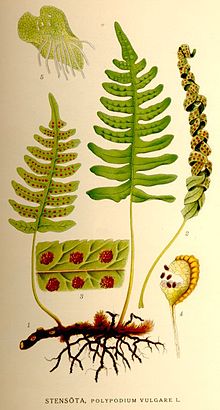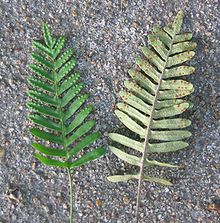- Polypodium vulgare
-
Polypodium vulgare 
Scientific classification Kingdom: Plantae Division: Pteridophyta Class: Polypodiopsida/Pteridopsida (disputed) Order: Polypodiales Family: Polypodiaceae Genus: Polypodium Species: P. vulgare Binomial name Polypodium vulgare
L. 1753Polypodium vulgare, the common polypody, is a fern of the Polypodiaceae family.
Contents
Description
The common polypody is a fern developing in isolation from along a horizontal rhizome. The fronds with triangular leaflets measure 10 to 50 centimetres. They are divided all the way back to the central stem in 10 to 18 pairs of segments or leaflets. The leaflets become much shorter at the end of the frond. The leaflets are generally whole or slightly denticulated and somewhat wider at their base, where they often touch each other. They have an alternating arrangement, those on one side being slightly offset from those on the other side. The petioles have no scales.
The sori are found on the lower side of the fronds and range in colour from bright yellow to orange. They became dark grey at maturity.
- Period of sporulation: July to September.
- Mode of dissemination: anemochory (wind dispersal).
Habitat
This fern is found in shaded and semi-shaded locations. It is found on old walls, cracks in rocks, the bases of trees and in rocky undergrowth. It prefers sandy soils and rarely tolerates lime.[citation needed]
Geographical distribution
The common polypody is very common in France, where it is found up to an altitude of 2000 m. It is less commonly found around the Mediterranean. It is also quite common in Scandinavia and Carpathian Mountains. In the United States it is commonly found in the Pacific Northwest (especially Oregon and Washington) from coastal areas inland and throughout the Cascades. It has been introduced to New Zealand and has begun to spread into the wild.
Uses
- In cooking: The rhizome has a bittersweet taste. It has traditionally been used in some confectionery such as nougat for its aromatic properties. In 1971, a saponin, osladin was found in the roots and believed to be the compound responsible for the sweet taste as it elicits a relative sweetness 500 times sweeter than sugar (by weight).[1]
- Medicinal: The dried rhizome has been used in traditional medicine as a purgative and vermifuge due to it containing phytoecdysteroids.[2]
-
Polypodium vulgare, sorus detail
Note
- The name Polypodium vulgare is sometimes applied to the Polypodium virginianum or rock polypody. Licorice fern is also known as Polypodium glycyrrhiza.
References
- ^ (English) J Jizba, L Dolejs, V Herout & F Sorm, "The structure of osladin — The sweet principle of the rhizomes of Polypodium vulgare L.", in Tetrahedron Lett., vol. 18, 1971, p. 1329-1332. DOI 10.1016/S0040-4039(01)96701-2
- ^ Camps, F. .; Claveria, E. .; Coll, J. .; Marco, M. P.; Messeguer, J. .; Mela, E. . (1990). "Ecdysteroid production in tissue cultures of Polypodium vulgare". Phytochemistry 29 (12): 3819. doi:10.1016/0031-9422(90)85339-H.
- Plants of the Pacific Northwest Coast. Copyright 1994. Jim Pojar and Andy MacKinnon. Lone Pine Publishing, Vancouver, BC.
- http://ecan.govt.nz/publications/General/CommonPolypodyAugust2008.pdf
- http://www.ct-botanical-society.org/ferns/polypodiumvirg.html
- This article incorporates information from the revision as of 28 Sep 2007 of the equivalent article on the French Wikipedia.
External links
- Den virtuella floran: Polypodium vulgare (Swedish)
Categories:- Polypodium
- Fern species
- Flora of Europe
Wikimedia Foundation. 2010.





